大学物理双语2012-2013-1月A
- 格式:doc
- 大小:107.00 KB
- 文档页数:4
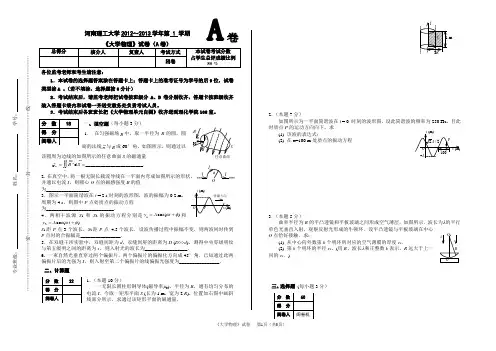
河南理工大学2012~2013学年第 1 学期各位监考老师和考生请注意:1.本试卷的选择题答案涂在答题卡上;答题卡上的准考证号为学号的后9位,试卷类型涂A 。
(若不填涂,选择题按0分计)2.考试结束后,请监考老师把试卷按班级分A、B卷分别收齐,答题卡按班级收齐装入答题卡袋内和试卷一齐送交教务处负责考试人员。
3.考试结束后各班班长把《大学物理单元自测》收齐送到理化学院108室。
1.在匀强磁场B中,取一半径为R的圆,圆面的法线n与B成60°角,如图所示,则通过以该圆周为边线的如图所示的任意曲面S的磁通量==⎰⎰⋅SmSBdΦ_______________________.2.在真空中,将一根无限长载流导线在一平面内弯成如图所示的形状,并通以电流I,则圆心O点的磁感强度B的值为_________________.3.图示一平面简谐波在t = 2 s时刻的波形图,波的振幅为0.2 m,周期为4 s,则图中P点处质点的振动方程为___________________________.4.两相干波源S1和S2的振动方程分别是)cos(1φω+=tAy和)cos(2φω+=tAy.S1距P点3个波长,S2距P点4.5个波长.设波传播过程中振幅不变,则两波同时传到P点时的合振幅是________________.5.在双缝干涉实验中,双缝间距为d,双缝到屏的距离为D (D>>d),测得中央零级明纹与第五级明之间的距离为x,则入射光的波长为_________________.6.一束自然光垂直穿过两个偏振片,两个偏振片的偏振化方向成45°角.已知通过此两偏振片后的光强为I,则入射至第二个偏振片的线偏振光强度为________________.10分)(磁导率μ0),半径为R,通有均匀分布的S (长为1 m,宽为2 R),位置如右图中画斜2.(本题7分)如图所示为一平面简谐波在t = 0 时刻的波形图,设此简谐波的频率为250 Hz,且此时质点P的运动方向向下,求(1) 该波的表达式;(2) 在x=100 m处质点的振动方程3.(本题5分)曲率半径为R的平凸透镜和平板玻璃之间形成空气薄层,如图所示.波长为λ的平行单色光垂直入射,观察反射光形成的牛顿环.设平凸透镜与平板玻璃在中心O点恰好接触.求:(1) 从中心向外数第k个明环所对应的空气薄膜的厚度e k.(2) 第k个明环的半径r k。
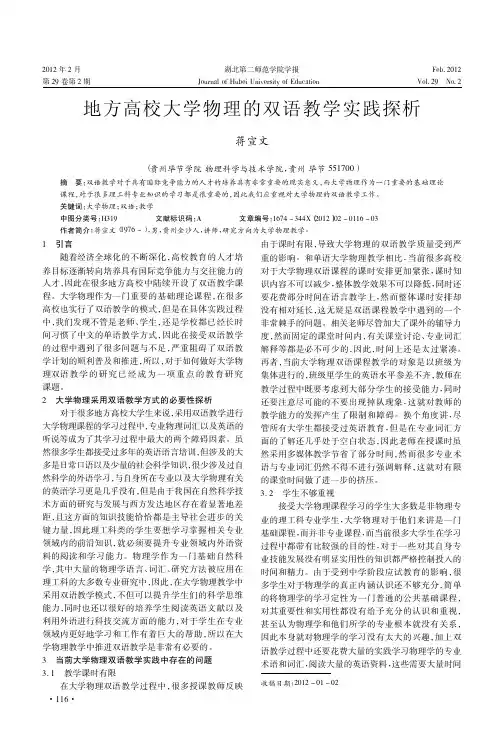
2012年2月湖北第二师范学院学报Feb.2012第29卷第2期Journal of Hubei University of EducationVol.29No.2地方高校大学物理的双语教学实践探析蒋宣文(贵州毕节学院物理科学与技术学院,贵州毕节551700)摘要:双语教学对于具有国际竞争能力的人才的培养具有非常重要的现实意义,而大学物理作为一门重要的基础理论课程,对于很多理工科专业知识的学习都是很重要的,因此我们应重视对大学物理的双语教学工作。
关键词:大学物理;双语;教学收稿日期:2012-01-02中图分类号:H319文献标识码:A文章编号:1674-344X (2012)02-0116-03作者简介:蒋宣文(1976-),男,贵州金沙人,讲师,研究方向为大学物理教学。
1引言随着经济全球化的不断深化,高校教育的人才培养目标逐渐转向培养具有国际竞争能力与交往能力的人才,因此在很多地方高校中陆续开设了双语教学课程。
大学物理作为一门重要的基础理论课程,在很多高校也实行了双语教学的模式,但是在具体实践过程中,我们发现不管是老师、学生,还是学校都已经长时间习惯了中文的单语教学方式,因此在接受双语教学的过程中遇到了很多问题与不足,严重阻碍了双语教学计划的顺利普及和推进,所以,对于如何做好大学物理双语教学的研究已经成为一项重点的教育研究课题。
2大学物理采用双语教学方式的必要性探析对于很多地方高校大学生来说,采用双语教学进行大学物理课程的学习过程中,专业物理词汇以及英语的听说等成为了其学习过程中最大的两个障碍因素。
虽然很多学生都接受过多年的英语语言培训,但涉及的大多是日常口语以及少量的社会科学知识,很少涉及过自然科学的外语学习,与自身所在专业以及大学物理有关的英语学习更是几乎没有,但是由于我国在自然科学技术方面的研究与发展与西方发达地区存在着显著地差距,且这方面的知识技能恰恰都是主导社会进步的关键力量,因此理工科类的学生要想学习掌握相关专业领域内的前沿知识,就必须要提升专业领域内外语资料的阅读和学习能力。
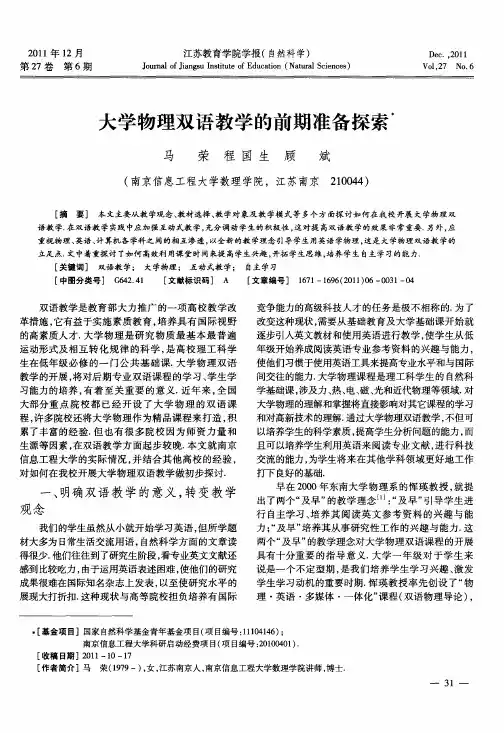
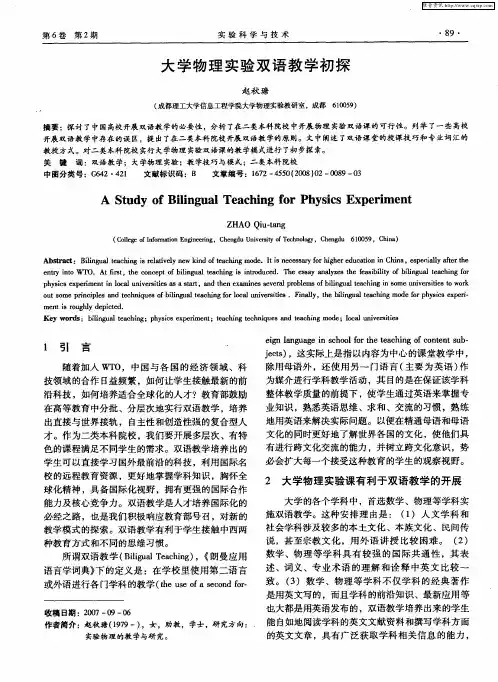
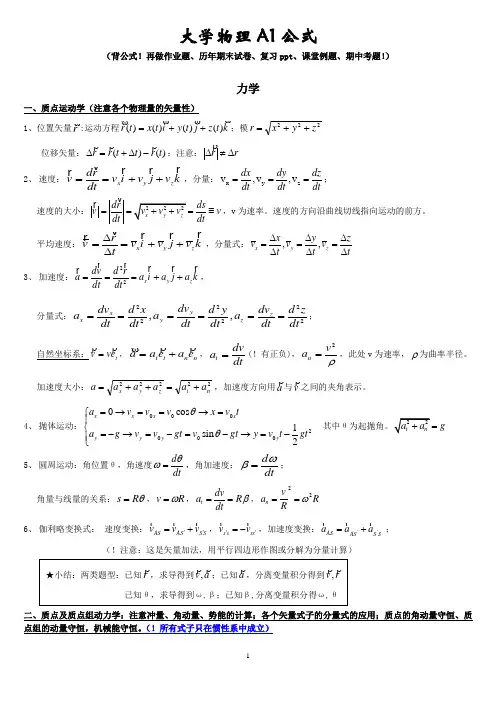
大学物理A1公式(背公式!再做作业题、历年期末试卷、复习ppt 、课堂例题、期中考题!)力学一、质点运动学(注意各个物理量的矢量性)1、位置矢量r:运动方程k t z j t y i t x t r )()()()(++=;模222z y x r ++=位移矢量:)()(t r t t r r -∆+=∆;注意:r r ∆≠∆2、 速度:x y z d r v v i v j v k d t ==++,分量:x y z v ,v ,v dx dy dz dt dt dt===;速度的大小:dr ds v v dtdt===≡,v 为速率。
速度的方向沿曲线切线指向运动的前方。
平均速度:x y z r v v i v j v k t ∆==++∆ ,分量式:,,x y z x y z v v v t t t∆∆∆===∆∆∆ 3、 加速度:22x y z dvd r a a i a j a k dt dt===++ , 分量式:222222,,y x z x y z dv dv dv d x d y d z a a a dtdtdtdtdtdt======;自然坐标系:t e v v =,n n t t e a e a a +=,t d v a d t =(!有正负),2n va ρ=,此处v 为速率,ρ为曲率半径。
加速度大小:22222n t z y x a a a a a a +=++=,加速度方向用a 与v 之间的夹角表示。
4、 抛体运动:00020000cos 1sin 2x x x x y y y y a v v v x v t a g v v gt v gt y v t gt θθ=→==→=⎧⎪⎨=-→=-=-→=-⎪⎩ 其中θg = 5、 圆周运动:角位置θ,角速度d dtθω=,角加速度:d d tωβ=;角量与线量的关系:θR s =,R v ω=,t dv a R dtβ==,22n v a R Rω==6、 伽利略变换式: 速度变换:AS AS S S v v v ''=+,s s ss v v ''=-,加速度变换:''AS AS S S a a a =+;(!注意:这是矢量加法,用平行四边形作图或分解为分量计算)二、质点及质点组动力学:注意冲量、角动量、势能的计算;各个矢量式子的分量式的应用;质点的角动量守恒、质点组的动量守恒,机械能守恒。
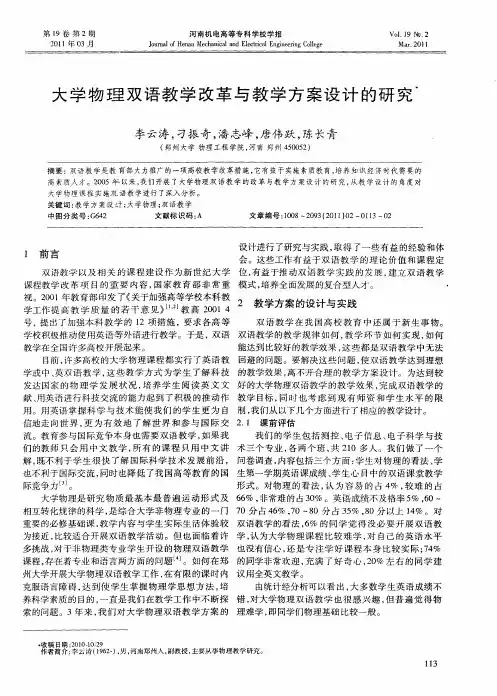
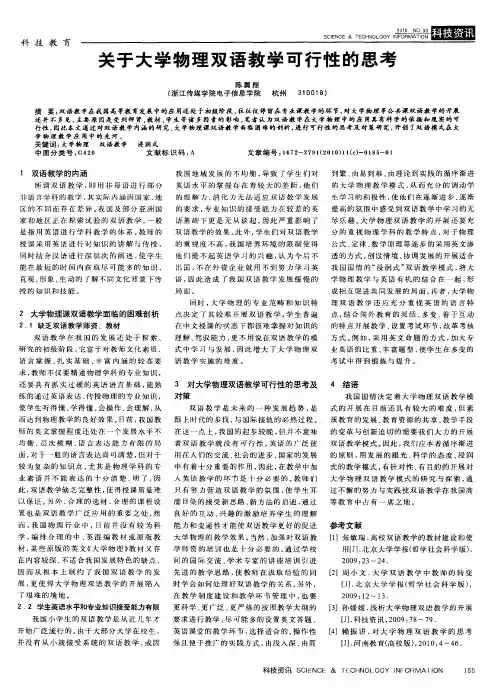
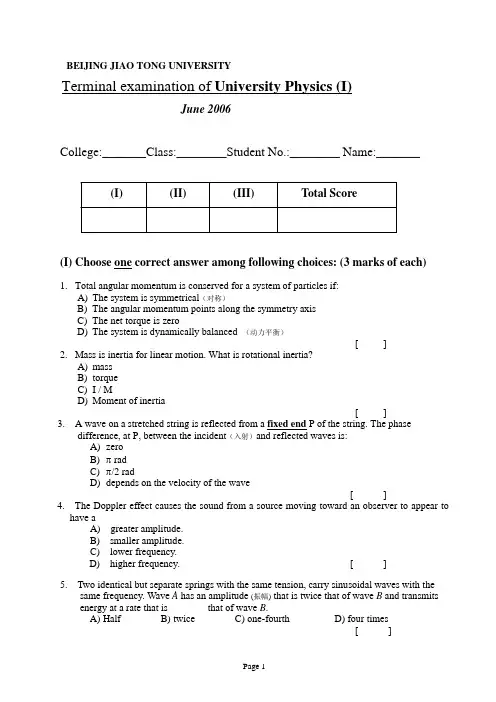
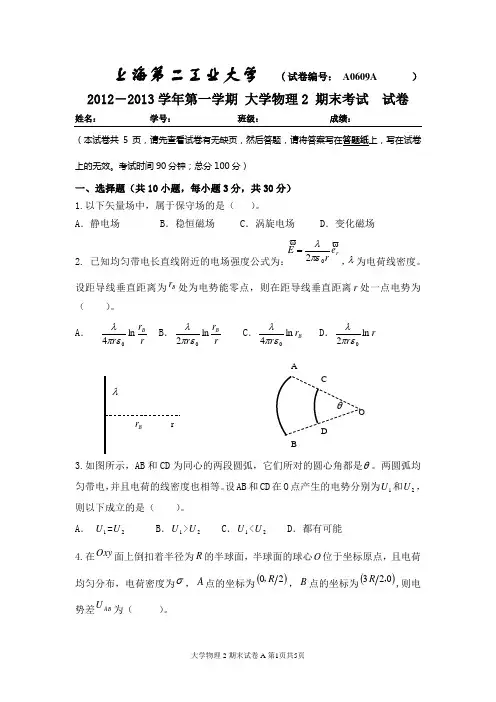
上海第二工业大学 (试卷编号: A0609A )2012-2013学年第一学期 大学物理2 期末考试 试卷姓名: 学号: 班级: 成绩:(本试卷共5页,请先查看试卷有无缺页,然后答题,请将答案写在答题纸上,写在试卷上的无效。
考试时间90分钟;总分100分)一、选择题(共10小题,每小题3分,共30分) 1.以下矢量场中,属于保守场的是( )。
A .静电场B .稳恒磁场C .涡旋电场D .变化磁场2. 已知均匀带电长直线附近的电场强度公式为:re r E02πελ=,λ为电荷线密度。
设距导线垂直距离为B r 处为电势能零点,则在距导线垂直距离r 处一点电势为( )。
A .r r r B ln 40επλ B .rr r B ln 20επλ C .B r r ln 40επλ D .r r ln 20επλ3.如图所示,AB 和CD 为同心的两段圆弧,它们所对的圆心角都是θ。
两圆弧均匀带电,并且电荷的线密度也相等。
设AB 和CD 在O 点产生的电势分别为1U 和2U ,则以下成立的是( )。
A . 1U =2UB .1U >2UC .1U <2UD .都有可能4.在Oxy 面上倒扣着半径为R 的半球面,半球面的球心O 位于坐标原点,且电荷均匀分布,电荷密度为σ,A 点的坐标为()20R ,,B 点的坐标为()023,R ,则电势差AB U 为( )。
A .06εσR B .02εσR C .0εσR D .023εσRABCDOθB rrλ5. 用图示分别表示三种球对称电场:(1)半径为R 的均匀带电球面;(2)半径为R 的均匀带电球体;(3)半径为R 电荷体密度为ρ =A/r (A 为常数)的非均匀带电球体,r E -关系曲线顺序正确的是( )。
A.a 、b 、cB. c 、a 、bC. c 、b 、aD. b 、c 、aa b c6.如图所示,均匀磁场B中,作一半径为R 的半球面S ,已知S 边线所在的平面法线方向与磁感应强度方向的夹角为α,则通过半球面S 的磁通量为( )。
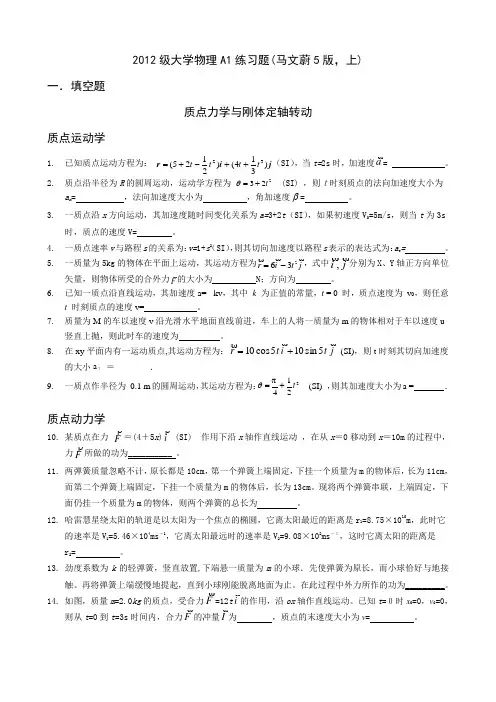
2012级大学物理A1练习题(马文蔚5版,上)一.填空题质点力学与刚体定轴转动质点运动学1. 已知质点运动方程为: j i r )314()2125(32t t t t ++-+=(SI ),当t=2s 时,加速度a = 。
2. 质点沿半径为R 的圆周运动,运动学方程为 223t +=θ (SI) ,则t时刻质点的法向加速度大小为a n = ,法向加速度大小为 ,角加速度β= 。
3. 一质点沿x 方向运动,其加速度随时间变化关系为a=3+2t (SI ),如果初速度V 0=5m/s ,则当t 为3s 时,质点的速度V= 。
4. 一质点速率v 与路程s 的关系为:v=1+s 2(SI ),则其切向加速度以路程s 表示的表达式为:a t = 。
5. 一质量为5kg 的物体在平面上运动,其运动方程为j t i r 236-=,式中j i ,分别为X 、Y 轴正方向单位矢量,则物体所受的合外力F 的大小为 N ;方向为 。
6. 已知一质点沿直线运动,其加速度a= - kv ,其中 k 为正值的常量,t = 0 时,质点速度为 v 0,则任意 t 时刻质点的速度v= 。
7. 质量为M 的车以速度v 沿光滑水平地面直线前进,车上的人将一质量为m 的物体相对于车以速度u 竖直上抛,则此时车的速度为 。
8. 在xy 平面内有一运动质点,其运动方程为:j t i t r 5sin 105cos 10+= (SI),则t 时刻其切向加速度的大小a τ =________.9. 一质点作半径为 0.1 m 的圆周运动,其运动方程为:2214πt +=θ (SI) ,则其加速度大小为a = . 质点动力学10. 某质点在力 F =(4+5x )i (SI) 作用下沿x 轴作直线运动 ,在从x =0移动到x =10m 的过程中,力F所做的功为__________ 。
11. 两弹簧质量忽略不计,原长都是10cm ,第一个弹簧上端固定,下挂一个质量为m 的物体后,长为11cm ,而第二个弹簧上端固定,下挂一个质量为m 的物体后,长为13cm 。
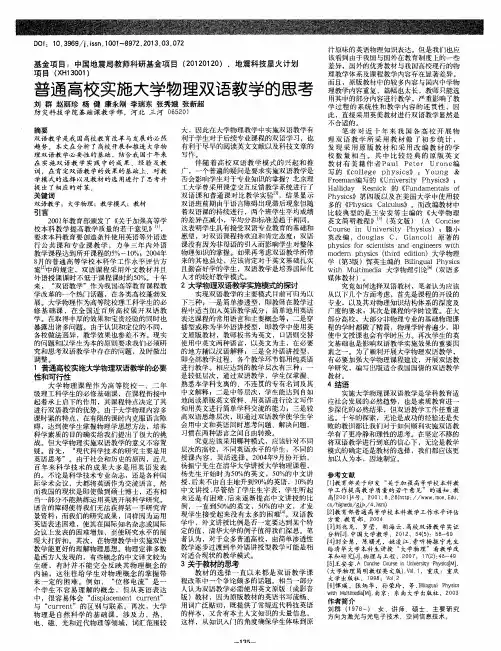
大学物理双语教学的探讨摘要:本文介绍了作者几年来进行大学物理双语课程教学积累的经验与体会。
从大学物理双语课程教学的意义、面临的困难、教材选择、课程体系设计、英语运用,以及与科研结合等几方面,探讨了在高校开展大学物理双语课程教学可行的措施与方案。
关键词:打学物理双语课程;双语教学;课程设计北京邮电大学从2005年面向国际学院04级开始开设大学物理双语课程,迄今3年,对2004级——2006级学生的教学中,取得了一些成功的经验。
在2007年3月,我们申请获得北京邮电大学教学研究与改革项目“大学物理双语课程教学的探索与实践”,面向2006届学生开设大学物理双语课程试点A班,研究在各个专业中基础课程取语教学的模式。
本文介绍我们在理工科大学生的主要基础课——大学物理课程双语教学的实践中的研究思路、具体做法和改革实践,就大学物理双语教学提出一些抛砖引玉的看法和建议。
一、大学物理双语教学的意义和面临的困难物理学是一门自然科学,研究自然界物质的运动形式和运动规律。
有一套完整的研究认识规律,和使用的语言无关,语言只是研究物理和描述自然的工具,不能替代科学的思维。
但是由于社会和历史的原因,近几百年来科学技术的成果大多是用英语发表的。
不论是科学技术专业杂志,还是各种国际学术会议,大都将英语作为交流语言。
从这个意义上可以说“现代科学技术的研究主要是用英语思考”。
从一个狭义的层面看,我国理工科硕士生、博士生的培养中,英语是必不可少的获取课题背景的重要工具。
然而国内大学的英语教学与专业课程脱钩的现状,造成我们多数硕士生和少量博士生还不能熟练运用英语开展科学研究。
比如论文开题阶段,学生宁愿去看国内杂志上有关课题“再加工”的综述文章,也不愿去查阅国外杂志上有关本课题的最原始的和最新近的相关文章,他们实际掌握的是第二手而不是第一手研究背景资料。
另外学生们运用英语表述困难,使他们的研究成果很难在国际知名杂志或国际会议上发表,以至使研究水平的展现大打折扣。
1. A particle moves along the x axis. Its position as a function of time is given by x=6.0t+8.5t 2, where t is in seconds and x is in meters. What is the acceleration as a function of time? Solution:We find the velocity and acceleration by differentiating x = (6.0 m/s)t + (8.5 m/s 2)t 2:v = d x /d t = (6.0 m/s) + (17 m/s 2)t ;a = d v /d t = 17 m/s 2.2. What is the centripetal acceleration of a child3.6m from the center of a merry-go-round?The child ’s speed is 0.85m/s.Solution: The centripetal acceleration i sa R = v 2/r = (0.85 m/s)2/(3.6 m) = 0.20 m/s 2 ,direction: toward the center.3. Huck Finn walks at a speed of 1.0m/s across his raft(that is,he walks perpendicular to the raft ’s motion relative to the shore).The raft is traveling down the Mississipppi River at a speed of 2.5m/s relative to the river bank.What is the velocity(speed and direction)of Hack relative to the river bank? Solution:If v HR is the velocity of Huck with respect to the raft, v HB the velocity of Huck with respect to the bank, and v RB the velocity of the raft with respect to the bank, then v HB = v HR + v RB , as shown in the diagram.From the diagram we get v HB = (v HR 2 + v RB 2)1/2 = [(1.0 m/s)2 + (2.5 m/s)2]1/2 = 2.7 m/s .We find the angle fromtan θ = v HR /v RB = (1.0 m/s)/(2.5 m/s) = 0.40, which gives θ = 22° from the river bank .4. A 75-m-long train accelerates uniformly from rest.If the front of the train passes a railwayworker 140m down the track at a speed of 25m/s,what will be the speed of the last car as it passes the worker?Solution: We use a coordinate system with the origin at theinitial position of the front of the train. We can find the acceleration of the train from the motion up to the point where the front of the train passes the worker: v 12 = v 02 + 2a (D – 0);(25 m/s)2 = 0 + 2a (140 m – 0),which gives a = 2.23 m/s 2.Now we consider the motion of the last car, which starts at – L , to the point where it passes the worker: v 22 = v 02 + 2a [D – (– L )]= 0 + 2(2.23 m/s 2)(140 m + 75 m), which gives v 2 = 31 m/s .5.what is the maximum speed with which a 1200-kg car can round a turn of radius 80.0m on a flat road if the coefficient of friction between tires and road is 0.55?Is this result independent of theRBHRv = 0mass of the car?Solution: If the car does not skid, the friction is static, with F fr ≤ μs F N .This friction force provides the centripetal acceleration. We take a coordinate system with the x -axis in the direction of the centripetal acceleration.We write ∑F = m a from the force diagram for the auto: x -component: F fr = ma R = mv 2/R ;y -component: F N – mg = 0.The speed is maximum when F fr = F fr,max = μs F N .When we combine the equations, the mass cancels, and we get μs g = v max2/R ;(0.55)(9.80 m/s 2) = v max 2/(80.0 m), which gives v max = 21 m/s .The mass canceled, so the result is independent of the mass .6. A thin rod of length l carries a total charge Q distributed uniformly along its length.Determine the electric field along the axis of the rod starting at one end-that is,find E(x) for 0x ≥.Solution: We choose a differential element of the rod d x ' a distance x ' from the origin of the coordinate system, as shown in the diagram. the limits for x ' are0 to l . The charge of the element is d q = (Q /l ) d x '. We find the electric field by integrating along the rod:''2'2'000000001111()4()4()4()44()|lll dq Q dx Q Q QE i i i i i x x l x x l x x l x l x x x l πεπεπεπεπε--====-=+++++⎰⎰7. The resistance of a packing material to a sharp object penetrating it is a force proportional to the fourth power of the penetration depth,x:F=kx 4i.Calculate the work done to force the sharp object a distanced.Solution: The resisting force opposes the penetration. If we assume no acceleration, the applied forcemust be equal to this in the direction of the penetration. For a variable force, we find the work by integration:W =F ·d s =kx 4d x 0d =kx55d =kd 55.8. A ball of mass 0.540kg moving east (+x direction) with a speed of 3.9m/s collides head-on with a0.320-kg ball at rest.If the collision is perfectly elastic,what be the speed and direction of each ball after the collision? Solution:For the elastic collision of the two balls, we use momentum conservation for this one-dimensionalmotion: m 1v 1 + m 2v 2 = m 1v 1' + m 2v 2';(0.540 kg)(3.90 m/s) + (0.320 kg)(0) = (0.540 kg)v 1' + (0.320 kg)v 2'.Because the collision is elastic, the relative speed does not change:F Nm gF fryxa Rv 1 – v 2 = – (v 1' – v 2'), or 3.90 m/s – 0 = v 2' – v 1'. Combining these two equations, we getv 1' = 0.998 m/s , and v 2' = 4.89 m/s .9. Derive the formula for the moment of inertia of a uniform thin rod of length l about an axis throughits center,perpendicular to the rod. Solution:We select a differential element of the rod of length d x a distance x from the center of the rod. The element is equivalent to a point mass with a mass of d m = (M /l) d x . We integrate from x = – l/2 to x = l/2 to find the moment of inertia of the rod:/22223/23/2/22|()33212l l l l MM M l Ml I x dm x dx x ll l --=====⎰⎰ 10. what is the magnitude of the electric force of attraction between an iron nucleus(q=+26e) and itsinnermost electron if the distance between them is 121.510m -⨯?Solution:The magnitude of the Coulomb force isF = kQ 1Q 2/r 2=(9229.010/N m C ⨯•)(26)( 191.610C -⨯)( 191.610C -⨯)/(1.5 ⨯ 10–12m)2= 2.7 ⨯ 10–3 N .11. The total electric flux from a cubical box 28.0 cm on a side is 321.4510/N m C ⨯•.What charge is enclosed by the box?Solution: The total flux is depends only on the enclosed charge:0QεΦ=or 12223280(8.8510/)(1.4510/) 1.281012.8Q C N m N m C C nC ε--=Φ=⨯•⨯•=⨯=12. A boat can travel 2.20m/s in still water.(a)If the boat point its prow directly across a stream whose current is 1.2m/s,what is the velocity(magnitude and direction) of the boat relative to the shore?(b)What will be the position of the boat,relative to its point of origin,after 3.00s? Solution:(a ) If v BS is the velocity of the boat with respect to the shore,v BW the velocity of the boat with respect to the water, and v WS the velocity of the water with respect to the shore, then v BS = v BW + v WS , as shown in the diagram.From the diagram we getv BS = (v BW 2 + v WS 2)1/2 = [(2.20 m/s)2 + (1.20 m/s)2]1/2 = 2.51 m/s. We find the angle fromtan θ = v BW /v WS = (2.20 m/s)/(1.20 m/s) = 1.83, which givesWSv BWθ = 61.4° from the shore.(b ) Because the boat will move with constant velocity, the displacement will bed = v BS t = (2.51 m/s)(3.00 s) = 7.52 m at 61.4° to the shore.13. A charge Q creates an electric potential of +125V at a distance of 15cm.What is Q?Solution:We find the charge from V = Q /4πÅ0r ;125 V = (9.0 ⨯ 109 N · m 2/C 2)Q /(15 ⨯ 10–2 m), which gives Q = 2.1 ⨯ 10–9 C = 2.1 nC.14. (a)What is the force per meter of length on a straight wire carring a 7.40A - current when perpendicular to a 0.90T -uniform magnetic field?(b)What if the angle between the wire and field is 45.0?Solution: a ) The maximum force will be produced when the wire and the magnetic field areperpendicular, so we have F max = ILB , or F max /L = IB = (7.40 A)(0.90 T) = 6.7 N/m . (b ) We find the force per unit length fromF /L = IB sin 45.0° = (F max /L ) sin 45.0° = (6.7 N/m) sin 45.0° = 4.7 N/m .15. An electron experiences the greatest force as it travels 62.910/m s ⨯ in a magnetic field when it is moving northward.The force is upward and of magnitude 137.210N -⨯.What is themagnitude and direction of the magnetic field?Solution:The greatest force will be produced when the velocity and the magnetic field are perpendicular. We point our thumb down (a negative charge!), and our fingers north. We must curl our fingers to the east, which will be the direction of the magnetic field. We find the magnitude from F = qvB ;7.2 ⨯ 10–13 N = (1.60 ⨯ 10–19 C)(2.9 ⨯ 106 m/s)B , which gives B = 1.6 T east .16. Two different dielectrics each fill half the space between the plates of a parallel-plate capacitor.Determine a formula for the capacitance in terms of 1K ,2K ,the area A of the plates,and the separation d. Solution:The potential difference must be the same on each half of the capacitor, so we can treat the system as two capacitors in parallel: C = C 1 + C 2 = [K 1Å0(1/2A )/d ] + [K 2Å0(1/2A )/d ] = (Å01/2A /d )(K 1 + K 2) = 1/2(K 1 + K 2)(Å0A /d )= Å0A (K 1 + K 2)/2d.17. Let two long parallel wires,a distance d apart,carry equal currents I in the same direction.One wireis at x=0,the other at x=d.Determine B between the wires as a function of x.Solution:Because the currents are in the same direction, between the wires the fields will be in opposite directions. For the net field we have B = B 1 – B 2 = [(μ0/4π)2I 1/x ]j – [(μ0/4π)2I 2/(d – x )]j = (μ0/4π)2I {[(d – x ) – x ]/x (d – x )}j= [(μ0/4π)2I (d – 2x )/x (d – x )]j .18. A 32-cm-long solenoid,1.8cm in diameter,is to produce a 0.30T - magnetic field at its center.If the maximum current is 5.7A ,how many turns must the solenoid have? Solution: We find the number of turns in the solenoid from B = μ0nI = μ0NI /L ;0.30 T = (4π ⨯ 10–7 T · m/A)[N /(0.32 m)](5.7 A), which gives N =1.3 ⨯ 104 turns .19. A spherical cavity of radius 4.50 cm is at the center of a metal sphere of radius 18.0 cm.A point charge 5.50Q C μ= rests at the very center of the cavity,whereas the metal conductor carries no net charge.Determine the electric field at a point(a)3.0 cm from the center of the cavity and (b)6.0 cm from the center of the cavity.Solution: From the symmetry of the charge distribution, we know thatthe electric field must be radial, with a magnitude independent of the direction.(a ) For a spherical Gaussian surface within the sphericalcavity, we have204enclosedQ QE dA E r πεε•=•==⎰,so we have692220(5.5010)(9.010/)4(0.030)QC N m C E r m πε-⨯⨯•==75.510/N C =⨯(away from the center)(b ) The point 6.0 cm from the center is inside the conductor,thus the electric field is 0.Note that there must be a negative charge of – 5.50 μC on the surface of the cavity and a positivecharge of + 5.50 μC on the outer surface of the sphere.20. How strong is the electricfield between the plates of a 0.80F μair-gap capacitor if they are2.0mm apart and each has a charge of 72 C μ? Solution: We find the potential difference across the plates fromdI 1B 1B 2I 2xxyQ = CV ;72 μC = (0.80 μF)V , which gives V = 90 V . We find the uniform electric field between the plates fromE = V /d = (90 V)/(2.0 ⨯ 10–3 m) = 4.5 ⨯ 104 V/m .21. Try to find out I of a uniform thin rod of mass m , length L about C (central )?dx dm λ=, dm x dI 2= dx x λ2= ⎰-=222L L c dx x I λ 3121L λ=2121mL =22. Protons move in a circle of radius 5.10cm in a 0.725-T magnetic field.What value of electric fieldcould make their paths straight?In what direction must the electric field point? Solution: For the circular motion, the magnetic force provides the radial acceleration: qvB = mv 2/r , or v = qBr /m .To make the path straight, the forces from the electric field and the magnetic field balance:qE = qvB = q (qBr /m )B , or E = qB 2r /m = (1.60 ⨯ 10–19 C)(0.725 T)2(0.0510 m)/(1.67 ⨯ 10–27 kg)= 2.57 ⨯ 106 V/m perpendicular to B .23.infinte line wire (E and B)。
一、Choice (4pts*5)1. Free expansion . A adiabaticcontainer has two parts connected bya valve (阀门). The volume of thetwo parts is the same ( Fig.1 ). Theleft part is filled with ideal gas (diatomic molecule 双原子分子)with temperature T . When the valve is opened, the gas will expand freely to fill both parts. After the system reach thermal equilibrium, the temperature of the gas is () (a) T (b) 2/T (c) 3/22/T (d) T 22 A red star and a blue star, which has higher surface temperature?(a) The red star (b) The blue star(c) They have the same surface temperature (d) Unable to determine3. A particle’s location is measured and specified as being exactly at x = 0, with zero uncertainty in the x direction. How does that location affect the uncertainty of its momentun component in the y direction?(a) It does not affect it. (b) It makes it infinite. (c) It makes it zero.4. Unpolarized light passes through two polarizers whose optical axes are in the same direction. The intensity of the emerging light is I 0. If a third polarizer is placed between the polarizers so that its axis is at an angle θ with the other two, the intensity of the emerging light is(a) zero (b) I 0 (c) I 0 cos 2θ (d) I 0 cos 4θ5. The following functions may represent the wave motion f (x ,t ) in a one-dimensional elastic medium in terms of position x , time t , and positiveconstants A , a , and b . Which function represents a traveling wave moving in the negative x-direction?(a) ()()bt ax At x f +=sin , (b) ()()bt ax A t x f -=sin ,(c) ()bt ax A t x f cos cos ,= (d) ()bt ax A t x f sin sin ,=Fig.1二、Blanks (20pts)6. (8 pts) A 500 g mass is undergoing simple harmonic oscillation that is described by the following equation for its position x (t ) from equilibrium:()⎥⎦⎤⎢⎣⎡+=rad 0.6rad/s 0.6cos )m 50.0()(ππt t x The amplitude A of the oscillation is m. The frequency of the oscillation is Hz. The period T of the oscillation is s. The phase of oscillator at t = 0 s is rad. The maximum speed of the oscillator is m/s .7. (3pts) When Newton ring apparatus is immersed in a liquid, the diameter of the eighth dark ring decreases form 2.92cm to 2.60cm, the refractive index of the liquid is .8. (3pts) In single slit diffraction experiment, 680nm light falls on a slit 0.0345mm wide. The angular width of the center diffraction peak is .9. (3pts) The angular separation of the two components of a double star is 8×10-3 rad and the light from the double stat har a wavelength of 550 nm. According to the Rayleigh criterion, the smallest diameter of a telescope mirror that will resolve the double star is ______ m.10. (3pts) The De Broglie wavelength of a electron moving at 5.9×106m/s is .三、Questions (10pts)11. (5pts) The oceans contains a tremendous amount of thermal energy. Why, in general, it is not possible to put it into useful work.12. (5pts) what are the two postulates of Einstein ’s Special Theory of Relativity?四、Problems (50pts)13. (10pts) For 1 mole O 2 at room temperature (20℃),(1) what is the average transitional kinetic energy of the molecules?(2) what is the rms speed of the molecules?(3) what is the internal energy of the gas?14. (10pts) The PV diagram of the cycle in Carnot ’s engine is shown in Fig 2. The Carnot cycle has 4 processes:1 2: Isothermal expansion with addition of heat |Q H |;2→3: Adiabatic expansion;3→4: Isothermal compression with heat |Q L | flowing out;4→1: Adiabatic compression.(1) Calculate |Q H | and |Q L |. (Suppose the gas is n mole) (2) Show that the efficiency of Carnot engine is H LT T -=1ηFig.215 (17pts) In the double - slit interference experiment (Fig. 3a), 550 nm light falls on the double-slit with two very narrow slit 0.10 mm apart. A viewing screen is 1.0 m far from the double-slit.(1) What is the separation between the 2nd-order bright fringe and the 3rd-order bright fringe?(2) A thin flake of mica (云母, n =1.58) is used to cover one slit of a double – slit (Fig. 3b). The central point on the viewing screen is now occupied by what had been the seventh bright slid fringe (m =7) before the mica was used. What is the thickness L of the mica?(3) Is the separation between adjacent bright fringes changed?16 (13 pts) A 1 kg mass oscillates on the end of a spring whose spring constant is k =2500N/m. If this system is in a spaceship moving pass the Earth with a speed of 0.8c, what ’s the period of the system seen by (1) the observers on the spaceship; (2) the observers on the Earth L 0.11mm 1.0m Fig. 3b 0.11mm1.0mFig. 3az。